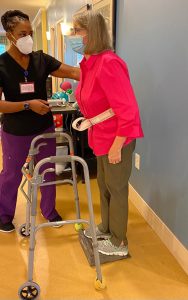Written By: Dr. Brandi Singleton, PT, DPT, CCI

- Worldwide, 37 million people have falls requiring medical attention each year
- In the US, each year over 3 million older adults are treated in emergency departments as a result of falls
- Worldwide, 800,000 people are hospitalized for falls every year
- Falls are the leading cause of death from injury in adults aged 65 and over in the US
- Falls are the second leading cause of unintentional injury deaths worldwide
- Remember: falling is not a normal part of aging – frequent falling is abnormal, just as illness is abnormal and should be treated as such, with prevention being the first order of business
Fall Prevention Tips
When working to reduce fall risk, don’t forget the basics, such as R&R (reaction & response). Here are a few tips on how to improve R&R:
Check Ankle Range of Motion
- Many of our patients are unable to access appropriate reaction strategies, beginning with the most basic, ankle strategy, because they do not have the range of motion to do so.
- Technique: have your patient spend some time standing on an incline board – this activity promotes increased flexibility of the Achilles tendon and gastric soleus complex, giving your patient improved ability to access ankle strategy, while also challenging standing balance during the exercise. This activity can be performed with or without an assistive device depending on the patient’s level of mobility and the amount of challenge that you are looking to provide during the activity
Check for Activation of Balance Strategies
- When you stress your patient to the point of loss of balance, do they respond with the proper order of balance strategies? (1: ankle strategy, 2: hip strategy, 3: stepping strategy)? Do they have no response at all or abnormal responses that limit their ability to correct loss of balance?
- If the response is impaired then we must work to improve the patient’s ability to tap into those built-in protective mechanisms that work to keep the body upright
- Technique: an excellent activity/exercise to both assess and challenge this area is utilizing compensatory stepping correction – to do this, have patient stand with feet together and for lateral exercise have patient lean sideways into your hand, then randomly release pressure and allow patient to correct. This can be done for anterior and posterior correction as well. For anterior you have patient lean forward into your hands and for posterior backward into your hands.
Patient’s with Retropulsion are NOT a Lost Cause!
- Patients with retropulsion (often a combination of posterior loss of balance, impaired reaction strategies, and fear of falling) are often very limited in their mobility due to fear and abnormal reactive responses. Often these patients become non-ambulatory or limited ambulators, not because they lack the strength and ability to ambulate, but because they are “crippled” by fear of falling, frequent falls, and inability to correct their balance misalignments, partly as a result of that strong fear and subsequent stunting of balance strategies.
- Technique: Have this patient stand unsupported with their back in front of a wall, beginning with them standing close enough that they are touching the wall and perform gradual progressions bringing them a bit away from the wall while incorporating reaching, stepping, or other therapeutic challenges. Having the wall behind the patient both prevents the them from falling and/or pushing backward and gives them the reassurance that they will not fall. This is a great way to build confidence and help this patient safely learn how to access the balance strategies they have been bypassing to improve their ability to maintain upright posture while performing dynamic movements and activities.
This blog has touched on just a few tips and techniques that can be pulled from our therapy toolboxes and utilized to give our patients more independence, safety, and confidence. Of course these are just a few small pieces of a vast and complicated puzzle that includes pieces both intrinsic and extrinsic to our patients. It is incredibly important to take a holistic approach when working to reduce fall risk in patients who have a history of falls or are at a high risk for falls. I hope that these tidbits were helpful and I hope that you will check out my Fall Prevention Strategies course for a more detailed and comprehensive approach to fall prevention!
Explore online continuing education courses from Brandi below:
Effective Functional Assessment and Testing
Transfemoral and Transtibial Amputee
Telehealth in the Skilled Nursing Facility
Visit summit-education.com for more information